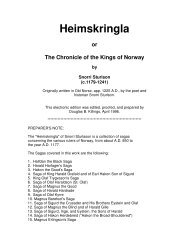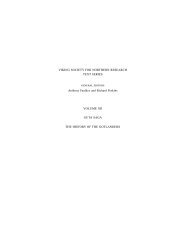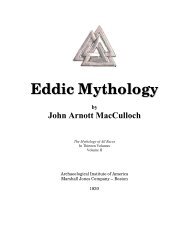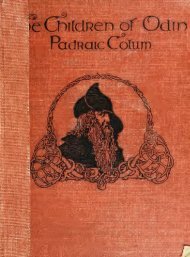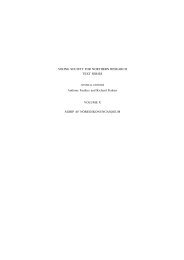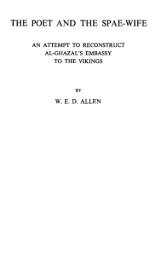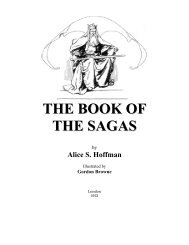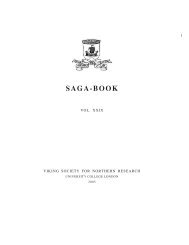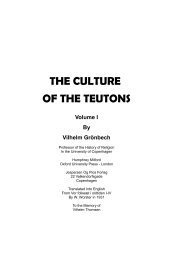- Page 7 and 8:
BEGINNERS' BOOK IN NORSE BY J. A. H
- Page 9 and 10:
PREFACE THIS book aims to give the
- Page 11 and 12:
CONTENTS Lesson Page I. Pronunciati
- Page 13:
Page Appendix 274 Norse-English Voc
- Page 16 and 17:
12 enced by other consonants, but i
- Page 18 and 19:
14 The e in her receives its qualit
- Page 20 and 21:
i6 6. -Net, ikke endda. 6. No, not
- Page 22 and 23: singular n. g.: et [e]. Singular. i
- Page 24 and 25: 20 Note i. Notice that in mand and
- Page 26 and 27: 22 The latter is falling out of use
- Page 28 and 29: 3rd person:
- Page 30 and 31: 26 VOCABULARY. Note. For system use
- Page 32 and 33: 28 that which is remote in time and
- Page 34 and 35: 3. Form original sentences using ad
- Page 36 and 37: 32 Drill. i. Change each example to
- Page 38 and 39: 34 READING. Jeg bar en ny hat og ny
- Page 40 and 41: pres. perf. : past perf.: fut. perf
- Page 42 and 43: a. Nu har han Icest en ny bok. b. /
- Page 44 and 45: 40 mother's sister, but your aunt i
- Page 46 and 47: 42 Hvilket brev er ditf Which lette
- Page 48 and 49: 44 og verbet at bruke. Verbet at ha
- Page 50 and 51: 46 hundrede is used as ordinal, but
- Page 52 and 53: 48 LESSON X. COMPOSITE WORDS. 31. W
- Page 54 and 55: 50 maanen og stjernerne. Vi sier at
- Page 56 and 57: 52 februar, den tredje mars, den fj
- Page 58 and 59: 54 than one, -}- tal), plural nemli
- Page 60 and 61: pres. perf.: er blit has (is) becom
- Page 62 and 63: almin'delig, -ly. forskjel'lig, ent
- Page 64 and 65: 6o we have dinner at one. 3. Some h
- Page 66 and 67: 62 39. Adjectives in the comparativ
- Page 68 and 69: 6 4 COMPOSITION. i. This lesson is
- Page 70 and 71: 66 at begynde [bejynTne], II, latin
- Page 74 and 75: stem -(n)ing or -en: at skrive (skr
- Page 76 and 77: 72 paa gulvet og gardiner for vindu
- Page 78 and 79: , 74
- Page 80 and 81: VOCABULARY. et bibliotek', er, libr
- Page 82 and 83: 78 which many claim to be [say is]
- Page 84 and 85: 8o 4. De gik side om side. 5. De sp
- Page 86 and 87: 82 60. Distinction in use of adverb
- Page 88 and 89: 84 1. Det regner; det sner; It rain
- Page 90 and 91: 86 3- Va/r der mange hjemme hos der
- Page 92 and 93: 5. baade den ene gangen lit. : both
- Page 94 and 95: 90 pres. perf. past fut. : har kunn
- Page 96 and 97: 92 82. The following verbs are pass
- Page 98 and 99: 94 en gjenstand [nn], e, ob- e'gent
- Page 100 and 101: 96 subjekt eller som objekt, siges
- Page 102 and 103: 98 nsevnes (altsaa uten nogen b^ini
- Page 104 and 105: 100 CONVERSATION. 1. Hvilken ordkla
- Page 106 and 107: 102 I regelmaessig komparation ende
- Page 108 and 109: en strae'ben, c. g., verbal noun fr
- Page 110 and 111: io6 Saa har vi en anden klasse, de
- Page 112 and 113: io8 et particip' (or participium),
- Page 114 and 115: no LESSON XXVI. VOCABULARY. et ansi
- Page 116 and 117: 112 written a D on the blackboard.
- Page 118 and 119: H4 ogsaa en. Fern, og fire, og tre,
- Page 120 and 121: LESSON n6 XXVIII. VOCABULARY. en sk
- Page 122 and 123:
4. at hale, to haul or pull (sailor
- Page 124 and 125:
120 Der var nsesten gaat nok 1 en t
- Page 126 and 127:
122 folk, n. g., people. at vare, I
- Page 128 and 129:
I24 CONVERSATION. i I. 2. 3- 4- tid
- Page 130 and 131:
126 Vistnok kan man hist og her se
- Page 132 and 133:
128 og stjzfrre eller mindre byer.
- Page 134 and 135:
130 LESSON XXXII. VOCABULARY. en vi
- Page 136 and 137:
132 Lasrdalspren i Sogn. ningsmetod
- Page 138 and 139:
134 Balholm i Sogn. Nedre Vasenden
- Page 140 and 141:
136 READING. Fjeld og dal. Norge er
- Page 142 and 143:
138 i de naermeste dalf^rer. Paa Ha
- Page 144 and 145:
140 Fra Folgefonnen, Hardanger. wit
- Page 146 and 147:
142 Valders: mellem Skogstad og Gri
- Page 148 and 149:
144 varte sine matvarer. Som navnet
- Page 150 and 151:
146 COMPOSITION. I. The Norsemen bu
- Page 152 and 153:
148 LESSON XXXV. VOCABULARY. en by,
- Page 154 and 155:
fra gaar gode veier og jernbaner ti
- Page 156 and 157:
152 Kristiania, utsigt fra Sankthan
- Page 158 and 159:
154 LESSON XXXVI. VOCABULARY. en je
- Page 160 and 161:
156 paa, og den var saa god at ban
- Page 162 and 163:
158 lov [lav], permission. at dr0mm
- Page 164 and 165:
og forbi, sa: "Om forlatelse." 4 Me
- Page 166 and 167:
162 at hvile, II, to rest. mast, ,
- Page 168 and 169:
i64 0yvind hadde hjzfrt at skolen v
- Page 170 and 171:
i66 ser ut. 7. Beskriv skolemestere
- Page 172 and 173:
i68 "Ja, gjerne det" "Men saa maa d
- Page 174 and 175:
170 4. Hvad var det som hjalp til a
- Page 176 and 177:
172 noget d^sig vind over sneen, so
- Page 178 and 179:
174 Se, denne historic var det som
- Page 180 and 181:
tsender vistes, og 0yvind kjendte e
- Page 182 and 183:
COMPOSITION. I. Near 0yvind's home
- Page 184 and 185:
i8o paa gaarden, satte sig inde en
- Page 186 and 187:
" 182 "Han danser godt." "Synes du?
- Page 188 and 189:
184 LESSON XLIII. VOCABULARY. en le
- Page 190 and 191:
i86 Faren sa, som sedvanlig, ikke s
- Page 192 and 193:
i88 5. Hvad er en kjaelkebakke ? 6.
- Page 194 and 195:
190 At fattigdommen stsengte til al
- Page 196 and 197:
192 4. Hvad visste 0yvind om disse
- Page 198 and 199:
. der 194 0yvind saa ned, aandednet
- Page 200 and 201:
1 96 7. heller ikke = nor either; n
- Page 202 and 203:
i 98 READING. Sjette kapitel Et hal
- Page 204 and 205:
20O han slet det h^ieste baatsmande
- Page 206 and 207:
2O2 brakes til hvis ban ikke slap.
- Page 208 and 209:
frem? 204 CONVERSATION. 1. Hvad var
- Page 210 and 211:
206 halvlukkede naar hun ikke netop
- Page 212 and 213:
208 for, and now he felt very much
- Page 214:
2IO "Tror du det er Gud som nu har
- Page 217 and 218:
213 swered wrong? What was wrong in
- Page 219 and 220:
215 I de dage man paa Pladsen forbe
- Page 221 and 222:
Notes. 1. at ta 0iemerke, to size u
- Page 223 and 224:
219 helsen 2 " fik han igjen. De sa
- Page 225 and 226:
221 klemt blev 0yvind, han vilde ga
- Page 227 and 228:
6. She answered that she ate well,
- Page 229 and 230:
225 daarlig. De kloke 0ine gik roli
- Page 231 and 232:
227 travelhet; det var som ban snub
- Page 233 and 234:
229 at knurre, I, to snarl, growl.
- Page 235 and 236:
231 du ; og da del blev godt imelle
- Page 237 and 238:
233 "Ja, det var saa," him 10p igje
- Page 239 and 240:
235 READING. Tiende kapitel. En eft
- Page 241 and 242:
laengere sug 10 . Nu 237 var ban ko
- Page 243 and 244:
239 tryg, t, ge, safe. skikkelig [s
- Page 245 and 246:
241 ham latterlyst. Dette saa Ole o
- Page 247 and 248:
et opgj0r, , settlement. en tunge,
- Page 249 and 250:
245 hvor der er gjaerende kraefter,
- Page 251 and 252:
247 nogen tilfaeldig skulde komme u
- Page 253 and 254:
249 at traede traadte traadt, of'fe
- Page 255 and 256:
251 ham vite fuldt ut hvor tungt de
- Page 257 and 258:
253 skjul og stuer, gik s^vnige til
- Page 259 and 260:
255 COMPOSITION. Write a summary of
- Page 261 and 262:
257 "Jeg holder meget paa den kjaer
- Page 263 and 264:
259 ende op til Nordistuen, lukker
- Page 265 and 266:
26l den? Dette maatte 10 jeg vite f
- Page 267 and 268:
263 Marken de gik over, var ikke go
- Page 269 and 270:
265 LESSON LXIII. VOCABULARY. en m0
- Page 271 and 272:
267 kjender, Brisker gjerne din hja
- Page 273 and 274:
269 moren oppe i kroken med 0inene
- Page 275 and 276:
delig ganske sagte: "Det har vaeret
- Page 277 and 278:
273 Hine taarer ved dansen var indg
- Page 279 and 280:
275 c. In some words d may be prono
- Page 281 and 282:
277 av- } fra-, frem- } gjen-, gjen
- Page 283 and 284:
279 plural postpositive article in
- Page 285 and 286:
28l nouns in 2 and 3 must not be co
- Page 287 and 288:
taket. Other examples: Han reiste f
- Page 289 and 290:
Common Gender. a. Names of living b
- Page 291 and 292:
287 sentence: Han talte som (like)
- Page 293 and 294:
289 c. Third class: a (aa, e) o a (
- Page 295 and 296:
NORSE-ENGLISH VOCABULARY. aa, er, c
- Page 297 and 298:
293 bak, baats'mand [ss nn], boatsw
- Page 299 and 300:
295 blaasort, , e, bluish black. bl
- Page 301 and 302:
297 D. da, adv., then; conj., when.
- Page 303 and 304:
299 eksamine're, II, to examine; to
- Page 305 and 306:
301 for 'ben, n. g., fore-leg. for'
- Page 307 and 308:
303 spare moment; time in which one
- Page 309 and 310:
305 grad, cr, c. g., degree. gradb0
- Page 311 and 312:
307 hive hivde hivd ( ct), to throw
- Page 313 and 314:
309 '.mot', against.
- Page 315 and 316:
klas'sisk, , e, classic(al). klemme
- Page 317 and 318:
313 kyllingh0ne, r, c. g., hen with
- Page 319 and 320:
315 lys, , n. g., light; candle, ly
- Page 321 and 322:
317 mulig, , e, possible. mund [nn]
- Page 323 and 324:
319 op 'stilling, c. g., arrangemen
- Page 325 and 326:
321 present [presang'], er, c. g.,
- Page 327 and 328:
323 saa, III, to sow. saa, so; thus
- Page 329 and 330:
325 to understand; to comprehend; t
- Page 331 and 332:
327 staur, er, c. g,. pole, stop. s
- Page 333 and 334:
329 svinge svang svunget, to swing.
- Page 335 and 336:
tomt, er, c. g., lot; ground traeff
- Page 337 and 338:
333 ut'bryte, br0t, brutt, to break
- Page 339 and 340:
335 vogn [vongn], e(r), carriage; w
- Page 341 and 342:
ENGLISH - NORSE VOCABULARY. animal,
- Page 343 and 344:
339 chalk, kridt, n. g. change, for
- Page 345 and 346:
341 far, langt. farewell, farvel. f
- Page 347 and 348:
343 literature, litteratur, c. g. l
- Page 349 and 350:
345 pier, brygge, r, c. g. overcome
- Page 351 and 352:
347 seem, syncs syntes syntes. sell
- Page 353 and 354:
349 walk, gaa gik opvarte, I. try,
- Page 358 and 359:
UNIVERSITY OF CALIFORNIA LIBRARY BE




